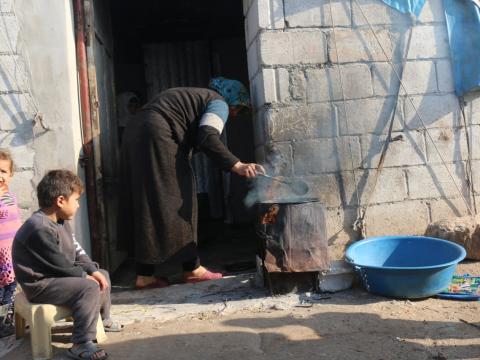From a Nutrition Specialist to the World

When I stepped into Ms. Hanada’s* tent, the atmosphere was heavy. Hanada, a mother of five, lives in conditions that can only be described as horrific. The tent that sheltered them barely protected them from the summer heat and the winter cold. In her previous births, Hanada had access to nearby medical points to follow up on her pregnancy and receive the micronutrients that were distributed as part of her healthcare. But with funding shrinking and many medical points closing, things became more difficult. When labor began in her last birth, she had to wait for hours while her husband tried to find a car to take her to the hospital, all amid fears that her baby would be born in the car on the way.
After Yaser* was born, Hanada was determined to breastfeed him, but poverty and lack of food made that a near-impossible task. Day after day, Hanada saw her baby deteriorate, and she did not have the resources to improve his condition. When I first visited them, Yaser was severely malnourished; his thin body and sunken eyes told a story of indescribable suffering. Hanada tried her best to feed him with whatever she could get her hands on, but all that was available were some herbs and spices. This was not enough, and it was clear that Yaser needed immediate intervention.
We examined Yaser and measured his mid-arm circumference, which was only 100 mm, a dangerous indicator of severe acute malnutrition. It was clear that Yaser needed intensive nutritional treatment and continuous follow-up. We started providing the necessary treatment and nutritional supplements, and we advised Hanada on how to improve her child’s nutrition under the difficult circumstances they were living in. It was not easy, but thanks to the continuous follow-up by our team, Yaser’s health gradually began to improve. After five months of close follow-up, Yaser had completely recovered from malnutrition. Yaser’s recovery was a source of great joy for his mother, and for all of us as a team.”

A displacement camp in Syria
World Vision Syria Response Partner, Physicians Across Continents
Hanada’s current living conditions are reflected by the situation in northwest Syria. We can no longer afford to wait or be complacent. As the conflict continues and the economic situation deteriorates, access to the most basic services has become almost impossible for most of the population. In 2024, it was a major shock when it was revealed that the humanitarian response had received only 6% of the required funding, leaving more than 3.6 million people severely food insecure with little or no support. Of these, only 625,000 people were targeted for food assistance, leaving millions more at risk of starvation.
The impact of the lack of funding does not stop at food provision alone but also extends to the health sector, which is one of the most vital sectors in such crises. It is estimated that 160 health facilities including 46 hospitals in northwest Syria may be forced to suspend their services entirely by mid-year if the necessary funding is not provided. This impending catastrophe will lead to high mortality rates among the population, especially among children and pregnant women, who are already among the most vulnerable groups.
In light of this general deterioration, the nutrition sector is particularly suffering from the catastrophic effects of the decrease in funding. The lack of financial support for nutrition programmes has led to a reduction in services provided, directly affecting the most vulnerable groups, such as children and pregnant and lactating women. Acute malnutrition rates among children are increasing at an alarming rate, reaching unprecedented levels in recent years. Statistics indicate that more than 3.8 million children in Syria are in need of life-saving food assistance. With funding declining, this assistance has become less available, increasing the risk of worsening the nutritional conditions of these children. Half of the children in Syria are suffering from severe acute malnutrition, reflecting the suffering of thousands of children from hunger and malnutrition. This not only means that these children are at risk of premature death, but also that if they survive, they will suffer from long-term health problems that may affect their physical and mental development.
This crisis is compounded by the deterioration of environmental and health conditions resulting from the recent earthquake that struck the region, which has further complicated the situation in northwest Syria. The population was already facing significant challenges, such as water scarcity and declining agricultural production, but the earthquake has added a new burden to these fragile communities. Roads and health facilities have been severely damaged, making it difficult for humanitarian organizations to reach the most affected areas. In light of these challenges, malnutrition rates among children have increased dramatically.
As funding continues to decline, the risk of hunger crisis is increasing in northwest Syria, where more and more families are suffering from severe food insecurity, putting the lives of millions at risk. Without immediate intervention and increased support, this crisis will continue to worsen, and hunger crisis will become a real threat to the lives of thousands of people, especially in camps and the most affected areas. This situation requires urgent intervention and a significant increase in funding to ensure the provision of essential humanitarian assistance and improve the living conditions of the population. Providing the necessary funding to support nutrition programs is crucial to avoid this humanitarian catastrophe. The international community and humanitarian organizations must step up their efforts to provide life-saving food assistance, and address the malnutrition crisis before it turns into a full-scale hunger crisis in Northwest Syria.”
*Names have been changed to protect identity